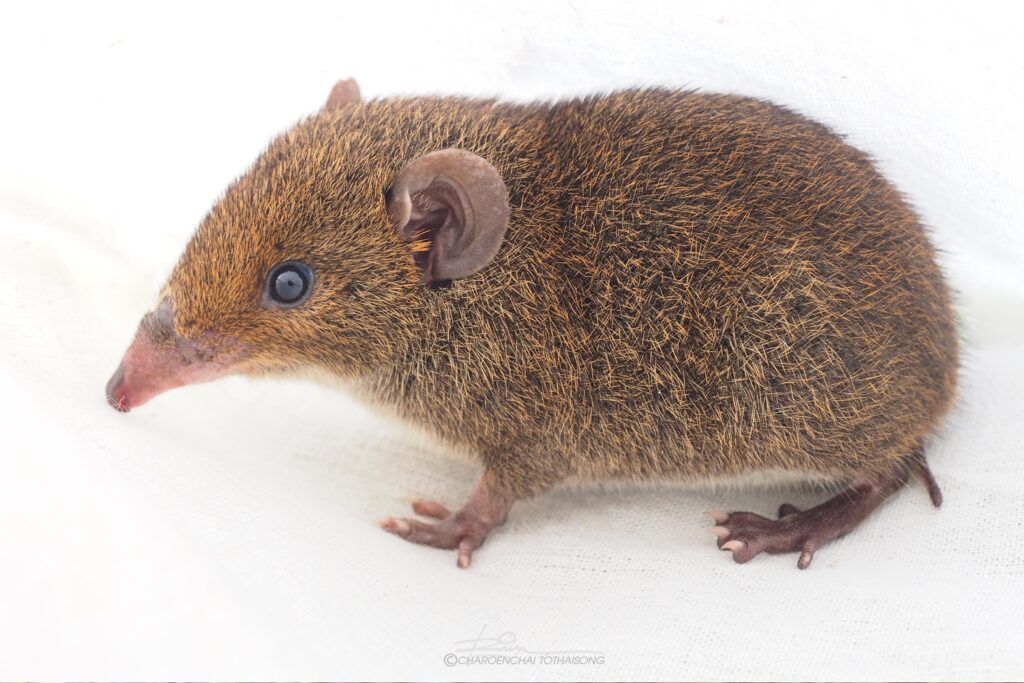If you cannot find the answer you are looking for, please contact us.
Northern short-tailed gymnure

First described in 1859, the Northern Short-tailed Gymnure was long thought to be a subspecies of the Short-tailed Gymnure, but molecular and morphological research in 2023 confirmed it as a distinct species widespread across mainland Southeast Asia.
Taxonomy
| Kingdom: | Animalia |
| Phylum: | Chordata |
| Class: | Mammalia |
| Order: | Eulipotyphla |
| Family: | Erinaceidae |
| Genus: | Hylomys |
| Species: | Hylomys peguensis |
Not a ‘real’ hedgehog
Despite its family ties to hedgehogs, the Northern Short-tailed Gymnure is part of the hairy hedgehogs (gymnures), not the true, spiny hedgehogs. It shares key traits with its spiny relatives: being nocturnal, insectivorous, and having a strong sense of smell. However, it lacks protective spines, cannot roll into a ball, and is covered in soft fur with a long tail, giving it a shrew-like appearance, even as a close evolutionary relative.
Natural range & habitat
This gymnure occurs across mainland Southeast Asia, including Myanmar, Thailand, Laos, Cambodia, Vietnam, and parts of Malaysia. It inhabits hilly lowland to moderate elevation forests, from about 100 to 1,000 meters above sea level, living in diverse habitats such as river valleys, dry evergreen or deciduous woodlands, thick undergrowth, and grassy forest edges.
Physical traits
A moderate-sized gymnure, it measures approximately 10–15.7 cm in body length, with a tail around 1.7–2.5 cm (~17 % of body length), and weighs between 45 and 73 g. Its fur is typically light brown on top and yellowish-brown to silvery below, with pale feet and a bicolored tail.
Behavior & lifestyle
The Northern Short-tailed Gymnure is assumed to be primarily ground-dwelling and mostly nocturnal, but does appear capable of limited climbing and may also be active during the day. Weak field observations, such as multiple captures of males and females in the same trap, suggest possible pairing behavior or overlapping territories during reproductive periods.
Communication
Direct observations are lacking. It is likely to rely on scent marking, tactile cues, and potentially soft vocalizations, consistent with related gymnure species, particularly for mating or territorial interactions.
Diet in the wild
This species is omnivorous with an insectivorous bias, feeding on insects like beetles, ants, butterfly larvae, and snails. In parts of its range, it will also consume fruits such as figs or vegetation from the genus Melastoma.
Reproduction & life cycle
Breeding likely occurs in spring to early summer, based on increased testes size in males (March) and pregnant females observed in late February and May. Documented litter sizes include two to four young.
Threats & conservation status
The Northern Short-tailed Gymnure is not yet separately assessed by the IUCN and remains grouped under the Short-tailed Gymnure, which is generally classified as Least Concern. However, its dependence on forested habitats means that deforestation and land conversion may pose threats. It occurs in several protected areas across its range.
This species in captivity
There are no known records of the Northern Short-tailed Gymnure being kept in captivity. Its elusive nature and specialized habitat needs make it unlikely to be part of captive programs, and conservation is necessarily focused on habitat protection and wild monitoring.
